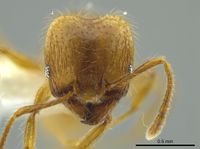Pheidole citrina
| Pheidole citrina | |
|---|---|

| |
| Scientific classification | |
| Kingdom: | Animalia |
| Phylum: | Arthropoda |
| Class: | Insecta |
| Order: | Hymenoptera |
| Family: | Formicidae |
| Subfamily: | Myrmicinae |
| Tribe: | Attini |
| Genus: | Pheidole |
| Species: | P. citrina |
| Binomial name | |
| Pheidole citrina Wilson, 2003 | |
Collected from leaf litter in wet forest. (Wilson 2003)
Identification
See the description in the nomenclature section.
Keys including this Species
Distribution
Atlantic lowlands of Costa Rica (Longino 1997).
Latitudinal Distribution Pattern
Latitudinal Range: 17.5155524° to 9.5802747°.
| North Temperate |
North Subtropical |
Tropical | South Subtropical |
South Temperate |
- Source: AntMaps
Distribution based on Regional Taxon Lists
Neotropical Region: Costa Rica (type locality), Guatemala, Honduras, Mexico, Nicaragua.
Distribution based on AntMaps
Distribution based on AntWeb specimens
Check data from AntWeb
Countries Occupied
| Number of countries occupied by this species based on AntWiki Regional Taxon Lists. In general, fewer countries occupied indicates a narrower range, while more countries indicates a more widespread species. |

|
Estimated Abundance
| Relative abundance based on number of AntMaps records per species (this species within the purple bar). Fewer records (to the left) indicates a less abundant/encountered species while more records (to the right) indicates more abundant/encountered species. |

|
Biology
Castes
Worker
Minor
Images from AntWeb
    
| |
| Worker. Specimen code casent0623856. Photographer Jeremy Pilllow, uploaded by University of Utah. | Owned by JTLC. |
Major
Images from AntWeb

| |
| Worker (major/soldier). Specimen code casent0624045. Photographer Jeremy Pilllow, uploaded by University of Utah. | Owned by JTLC. |
Nomenclature
The following information is derived from Barry Bolton's Online Catalogue of the Ants of the World.
- citrina. Pheidole citrina Wilson, 2003: 401, figs. (s.w.) COSTA RICA.
Unless otherwise noted the text for the remainder of this section is reported from the publication that includes the original description.
Description
DIAGNOSIS A very small, yellow member of the flavens group whose major is marked by its strongly curved propodeal spine (as though the tip had “melted” backward); long scapes, which reach the occipital corners; all of the sculpturing on the anterior half of the head consisting of longitudinal carinulae, with the posterior half smooth and shiny; and pronotal humerus in dorsal-oblique view rounded. Similar to onyx, but in the major, citrina has a more curved propodeal spine, far less carinulation on the dorsal head surface, and longer scapes, among other differences.
See also the less similar Pheidole grex and Pheidole humida.
MEASUREMENTS (mm) Holotype major: HW 0.66, HL 0.70, SL 0.54, EL 0.06, PW 0.38. Paratype minor: HW 0.46, HL 0.50, SL 0.54, EL 0.10, PW 0.28.
COLOR Major and minor: concolorous yellow.
Figure. Upper: holotype, major. Lower: paratype, minor. Scale bars = 1 mm.
Type Material
COSTA RICA: La Selva Biological Station, near Puerto Viejo, col. M. Byrne. Museum of Comparative Zoology
Etymology
L citrina, of citron, referring to yellow body color.
References
- Wilson, E. O. 2003. Pheidole in the New World: A dominant, hyperdiverse ant genus. Harvard University Press, Cambridge, MA.(page 401, fig. major, minor described)
- Varela-Hernández, F., Flores-Zapoteco, D. 2024. New Miocene Mexican amber ant (Formicidae, Myrmicinae) of the genus Pheidole Westwood, 1839. Historical Biology, pp. 1–6 (doi:10.1080/08912963.2024.2312403).
References based on Global Ant Biodiversity Informatics
- Dattilo W. et al. 2019. MEXICO ANTS: incidence and abundance along the Nearctic-Neotropical interface. Ecology https://doi.org/10.1002/ecy.2944
- Fernández, F. and S. Sendoya. 2004. Lista de las hormigas neotropicales. Biota Colombiana Volume 5, Number 1.
- Longino J. T. 2013. Ants of Nicargua. Consulted on 18 Jan 2013. https://sites.google.com/site/longinollama/reports/ants-of-nicaragua
- Longino J. T. L., and M. G. Branstetter. 2018. The truncated bell: an enigmatic but pervasive elevational diversity pattern in Middle American ants. Ecography 41: 1-12.
- Longino J. T., J. Coddington, and R. K. Colwell. 2002. The ant fauna of a tropical rain forest: estimating species richness three different ways. Ecology 83: 689-702.
- Longino J. et al. ADMAC project. Accessed on March 24th 2017 at https://sites.google.com/site/admacsite/


